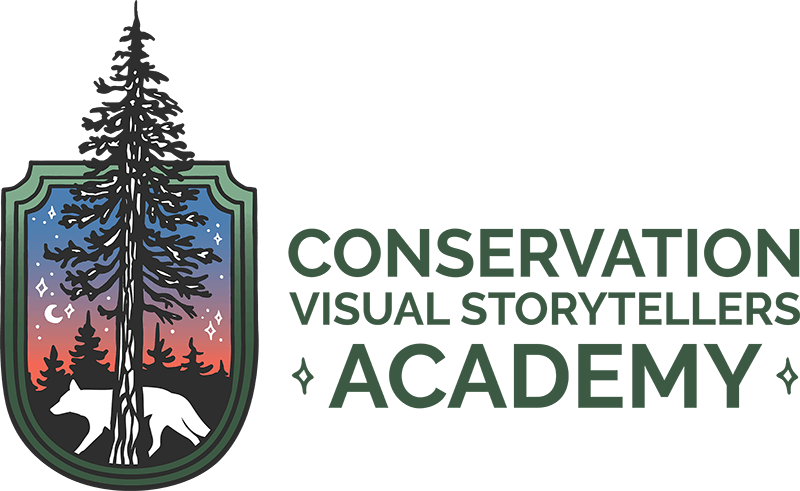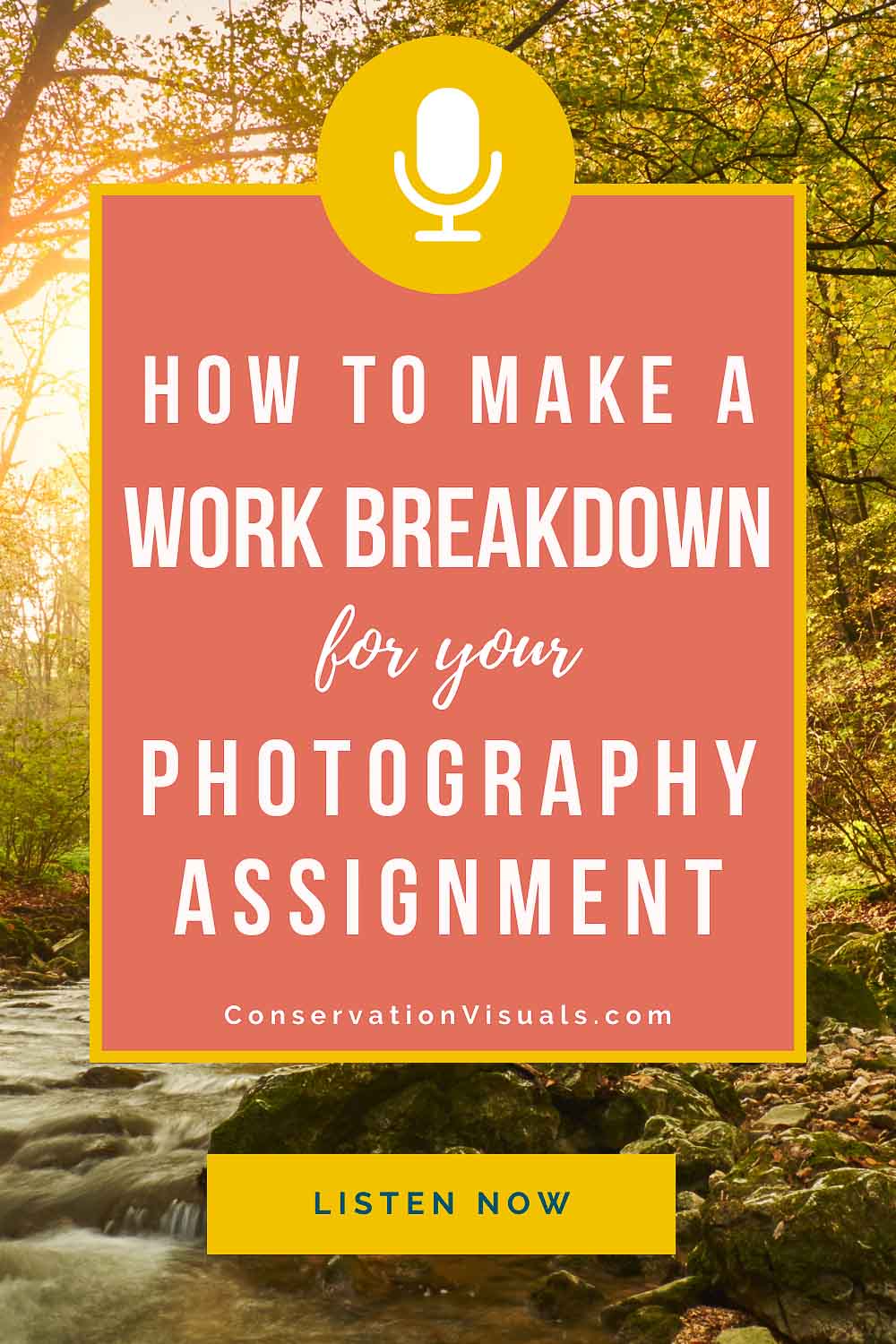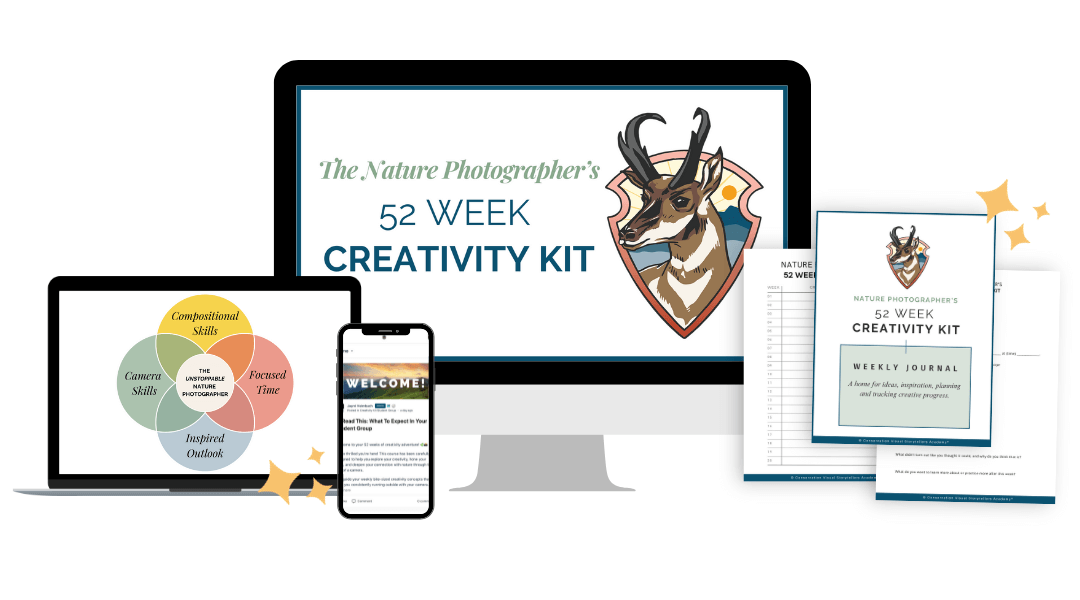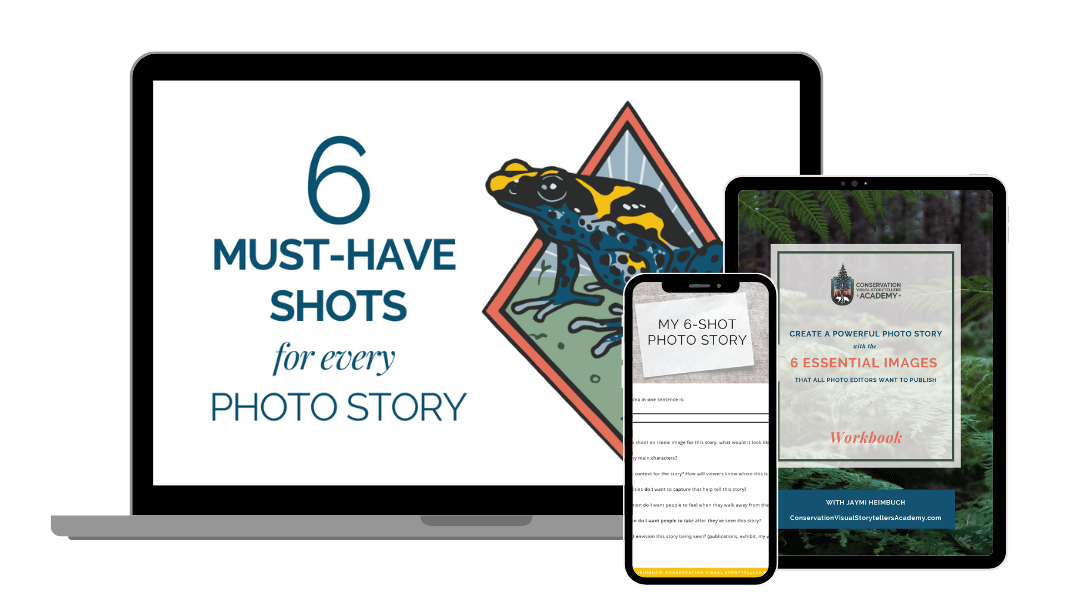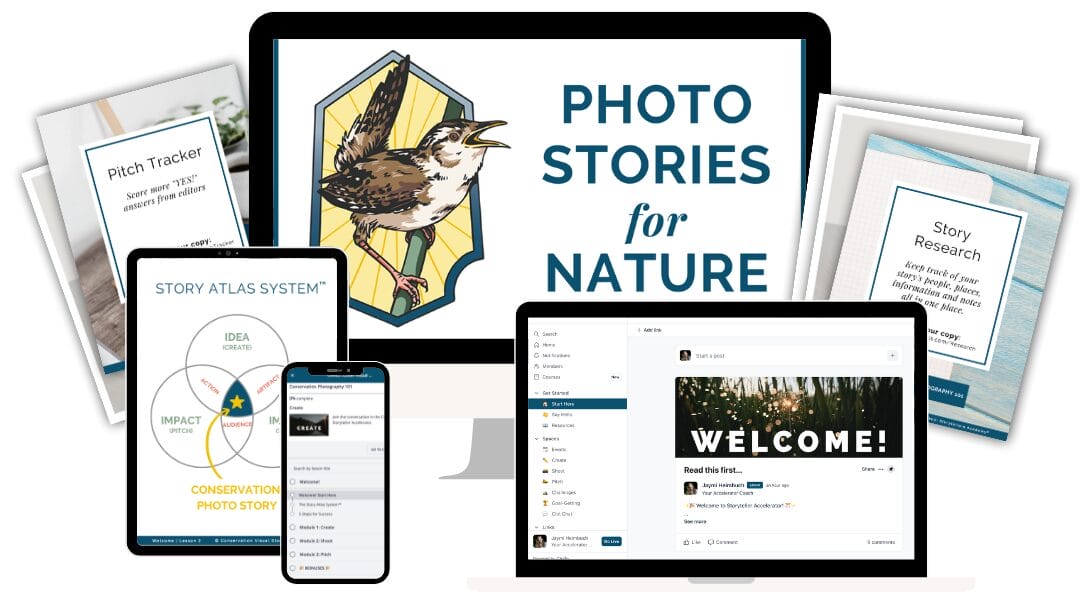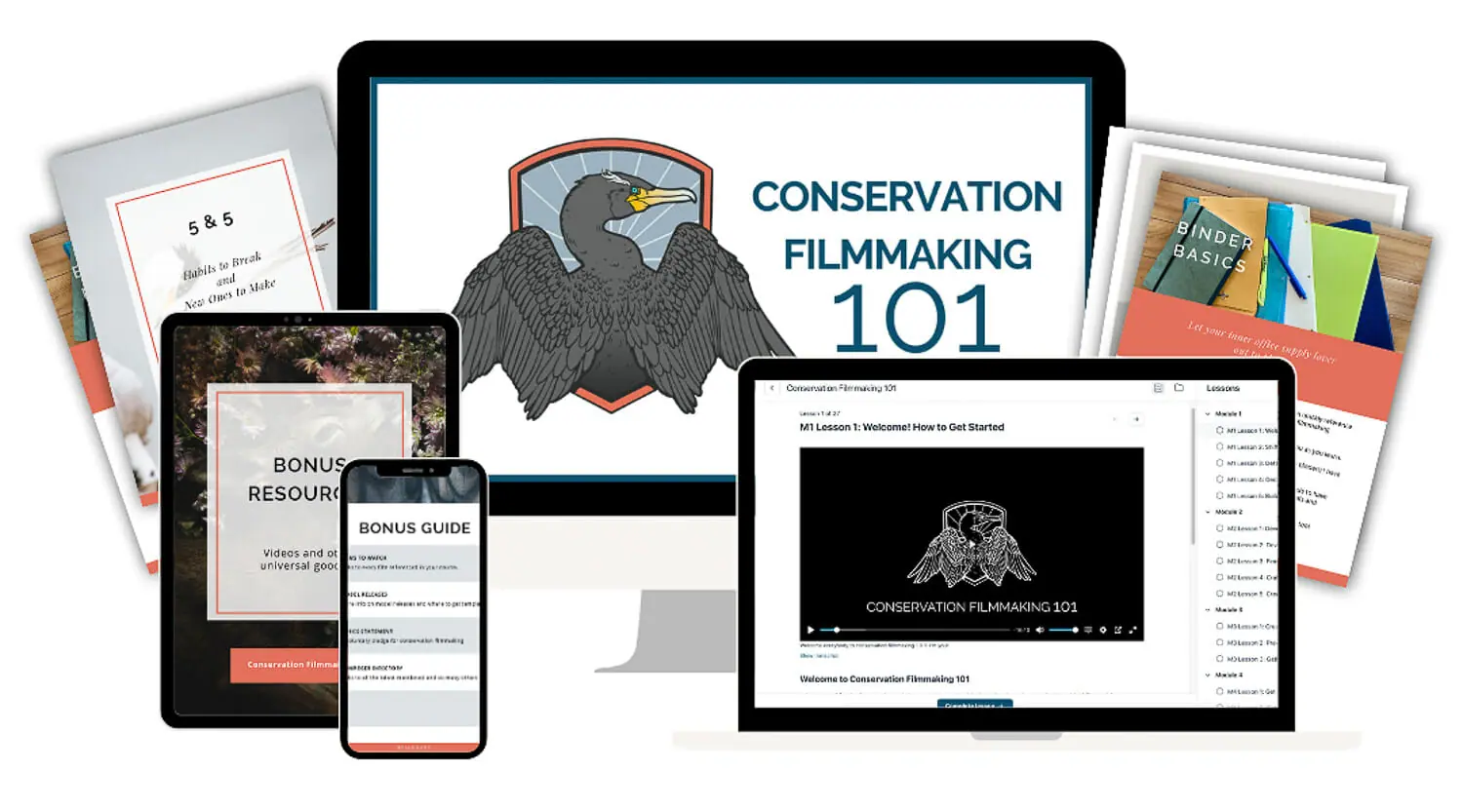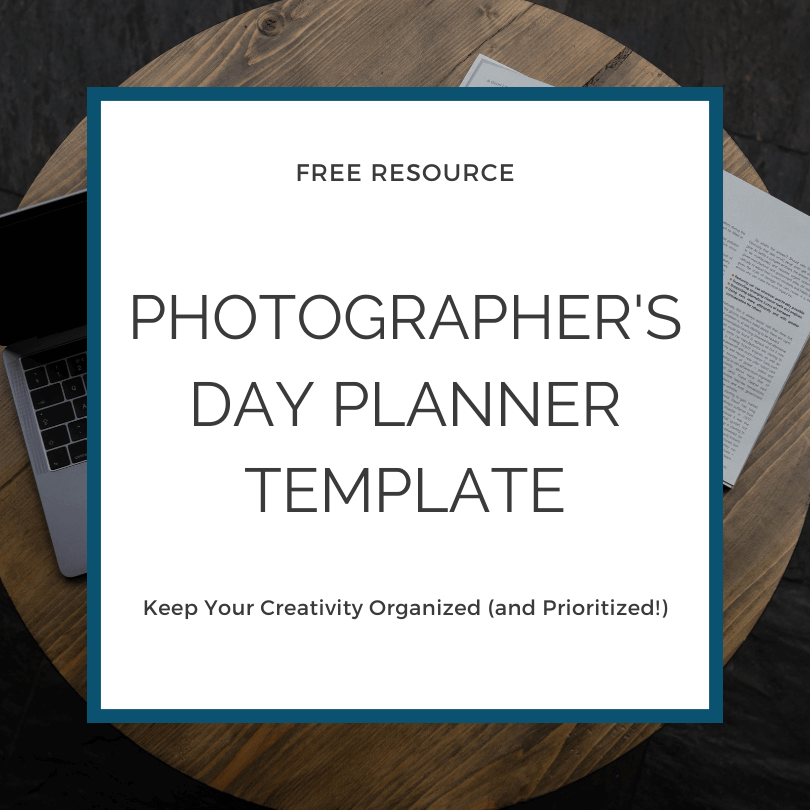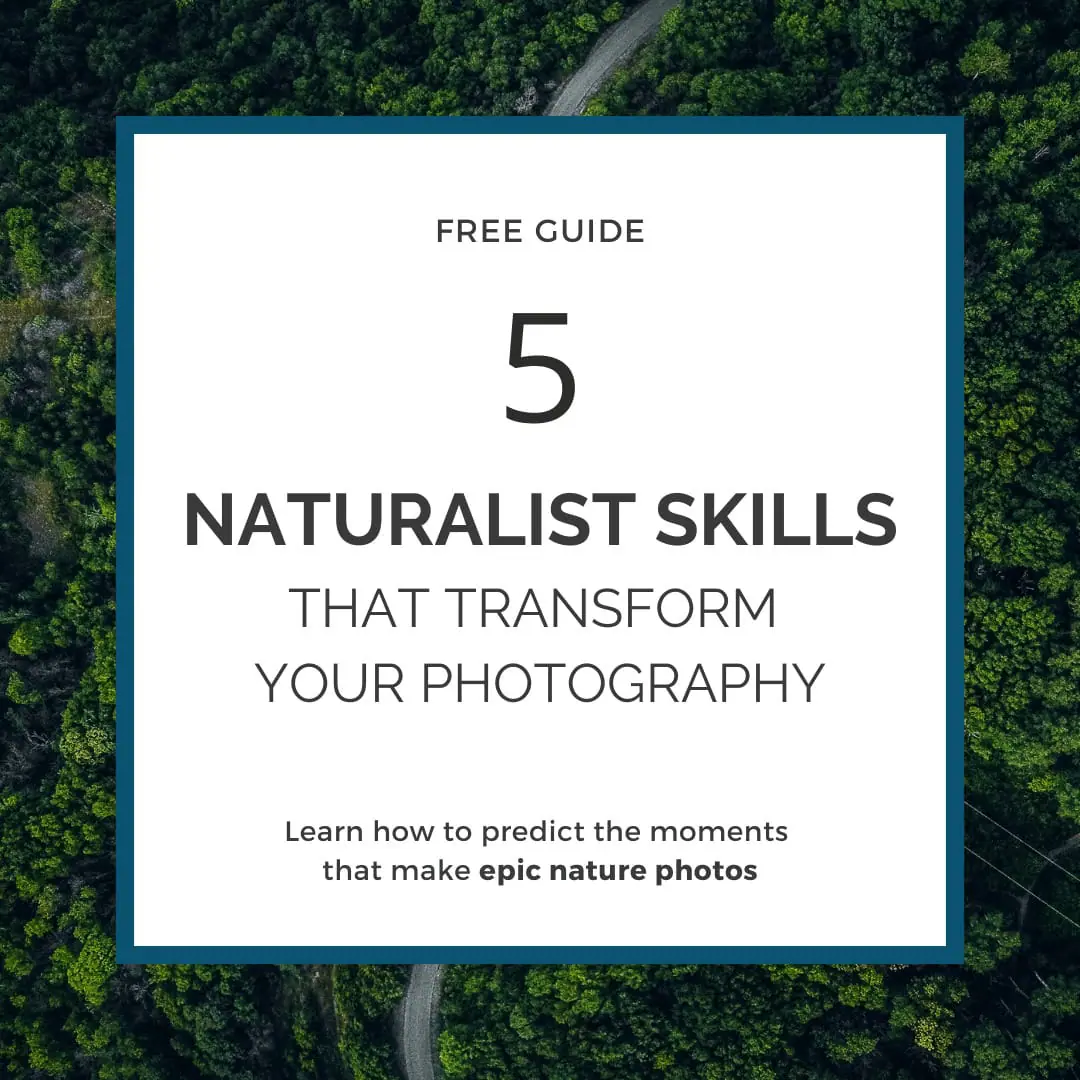Your Photo Projects Needs A Work Breakdown & Here’s How to Create One
A work breakdown is your ultimate to do list, giving you clarity, sanity, and yep, even more creative freedom inside of your conservation photography project.
Here's how to build one for your photography project!
In the previous article, we discovered the magic of a scope of work – your trusty sidekick in maintaining sanity and boosting creativity throughout a conservation photography project. With your goals, expectations, and timeframes set, you might think it's time to dive in headfirst, right?
Hold on! There's another essential tool you'll need: a work breakdown.
In this article, we'll explore how a work breakdown is your ultimate to-do list, providing you with a sense of calm and, believe it or not, even more creative freedom within your conservation photography project.
Why a work breakdown is essential for your photography projects
Think of a work breakdown as your trail map to success. It's a comprehensive list of all the tasks needed to complete your project.
While it may seem tedious, especially when planning familiar tasks, there are a few critical reasons why it's worth the effort:
1. Avoid surprises that can slow your progress: Investing a little time to think through all necessary tasks reduces the chances of unexpected obstacles. Sure, life will always throw curveballs, but with most work identified, you'll have fewer surprises and be better equipped to handle them.
2. Free your creativity: A fun project, let alone a successful one, means that you enjoy what you're doing and can enjoy the results of your effort. And a big reason why something is enjoyable is because it goes smoothly. Set your expectations and parameters right away so that you can relax into the work and free your creative mind to have a blast with your project.
3. Control change rather than letting change control you: The more structure you create upfront, the more flexibility you'll have during your project. A clear understanding of the work involved early on allows you to make decisions with clarity and confidence when surprises arise or changes occur.
4. Make it faster and easier to plan future projects: Many photography projects look similar in structure. If you put the work into creating a detailed work breakdown now, you can recycle it for future projects. Just cut, paste, mildly customize, and off you go!
It may seem challenging at first, but trust me; it gets easier. I've created a work breakdown template that I use for nearly every project I work on, and it's quite comprehensive.
In fact, you are welcome to use my own template to get going! Grab it for free below.
Now that you understand the importance of a work breakdown let's look at how to create one.
Preparation for making a work breakdown
Drafting a work breakdown is a fun process that helps you suss out everything that'll go into a project – and often even helps you come up with ideas for the project you wouldn't have thought of before.
To begin:
1. Set aside 1-2 hours to draft your first version, but don't worry about perfection. Plan for revisions and additional details as your project progresses.
2. Have your scope of work handy for reference, as you'll pull from this for the work breakdown.
A scope of work and a work breakdown complement each other beautifully. Imagine the scope of work as an aerial view of the landscape you're about to explore, and the work breakdown is the detailed trail map to guide you to your destination.
Ready to embark on your next conservation photography adventure? With a scope of work and a work breakdown in hand, you'll be well-prepared to navigate the journey ahead.
How to draft a work breakdown for a photography project in 7 steps
So, what goes into a work breakdown? There are seven sections that I always include:
1. Objective
This can be the same as the scope of work premise or more specific to this particular work breakdown. For example, suppose you're working on a large project with multiple components. In that case, your work breakdown can address just one part of the overall project.
2. Deliverables
These can be pasted in from your scope of work or made more specific if you're working on a particular chunk of a project. They're the actual products of your work – the physical artifacts that you'll hand over to a client, gallery, or publisher when you're done with the project.
3. Out of Scope
Just as you need to write out what you're doing, it's essential to note what you're not doing. This prevents your project from snowballing into something too big or vague to accomplish.
4. Tasks
This is the core of a work breakdown. It's your opportunity to sit down and think about all the little things involved in accomplishing a task.
This section of the work breakdown is especially important because getting clear on the tasks involved in pulling off a project informs how long it'll really take to create – which informs the schedule, the cost estimates, and more.
It's easy to list a few big, obvious tasks and call it a day. But that's misleading – there's usually much more to do hiding under the surface of those big, obvious tasks.
In the long run, it pays off to dig deeper during this section and figure out all that's REALLY involved in the tasks. So, let's take a closer look at how quickly one task can reveal itself to be a whole list of tasks when you pay attention to detail.
To illustrate this point, let's consider a simple example: scheduling the photography portion of a story assignment.
At first glance, it seems pretty straightforward – check your calendar, pencil in some fieldwork dates, and you're good to go, right? Well, not quite.
When you dig deeper, you'll find that you also need to coordinate with your contacts, make travel arrangements, organize gear, rent equipment, and more.
Suddenly, that “quick” fieldwork turns into several days of preparation, and we haven't even touched on the shoot itself, let alone processing photos and editing them yet!
By breaking down each task into its various components, you gain a realistic understanding of the time and effort required for your project. Plus, once you've done this in-depth analysis, you can easily recycle and adapt it for future projects – making your life that much easier!
Another significant benefit of a detailed work breakdown is that it helps you create a manageable schedule.
Let's say you're pitching to a new editor and think you can write and send the pitch in just one day. But when you examine all the necessary steps – like getting feedback, selecting images, and writing captions – you may realize it's actually a week's worth of work.
Having a clear picture of the time needed for each task allows you to craft a realistic schedule, preventing that overwhelming feeling of being swamped or caught off guard by unexpected tasks.
With a well-planned work breakdown, you can breathe easy and focus on what you love – capturing incredible images and telling impactful stories.
So, the fourth section of a work breakdown, the Tasks, is your key to unlocking a smoother, more enjoyable project experience. Embrace the power of thorough planning and watch your photography projects thrive!
5. Cost Estimates
Including cost estimates is important for two reasons: practicality and strategy. Knowing how much you'll spend helps with budgeting while strategically identifying tasks that may still be overlooked. For instance, budgeting for rental gear could remind you to research, price, schedule rentals, and factor in shipping times – tasks that might have been missed otherwise. By examining costs, you minimize obstacles and potential surprises, getting ahead of the curve.
6. Schedule
After outlining tasks thoroughly, create a timeline for accomplishing them. The trick is to work backward from the due date, ensuring everything is in order.
If your schedule seems tight, there are three ways to handle it:
- Rejigger or delete non-mission-critical tasks.
- Adjust deliverables to fit the available time.
- Renegotiate deadlines with clients before starting the project.
Scheduling brings the work breakdown map together, allowing you to see the project's realities and adjust your plan accordingly. This clarity provides the freedom to be creative, focused, energized, and professional throughout the entire project.
7. Links to other resources
This is where you ensure you have quick access to everything you're using for your project, such as budget sheets and contact lists. Having these at your fingertips keeps you organized and informed.
And there you have it! The seven sections of a work breakdown.
A detailed work breakdown and timeline are essential tools for maintaining organization and clarity throughout a conservation photography project.
By carefully planning tasks, budgets, and schedules, you can minimize obstacles and surprises, ultimately leading to greater success and creativity.
So, embrace the power of a well-planned work breakdown and watch your conservation photography projects flourish!
Episode 016: Your Photo Project Needs A Work Breakdown & Here's How to Create One
Shownotes: ConservationVisuals.com/16
(Digitally transcribed, please forgive any typos)
________________
Jaymi Heimbuch:
Welcome to feeling organized. So in Episode 15 we talked all about a scope of work and how a scope of work is basically your best buddy in maintaining a sanity and boosting your creativity during a conservation photography project. With that scope of work, you set your goals and your expectations and your time frames for your project. Now that you have the clarity from your scope of work in hand, it's time to jump in and start getting things done right? Well, not quite yet. See, in order to do that, there's a second tool that you wanna have in hand, and it is a work break down. In this episode, we're going to talk about how work breakdown is your ultimate to do list, and it is going to give you so much sanity And yep, even more creative freedom inside of your conservation photography project. And before we dive into the details, I want to let you know that, of course, I have a template waiting for you. You can download your free work breakdown template at JaymiH.com/16. The number 16 for this episode. You definitely want to head over and grab that template along with the template for the scope of work. Because these two tools having these templates in hand, it's going to speed everything along, and you're gonna have a lot more fun building out these tools. I promise you that it is actually fun. It's going to help you to think about your project in new and really fun ways. All right, let's go ahead and dive in to the details.
Welcome to impact the conservation photography podcast. I'm your host, Jaymi Heimbuch. And if you are a visual storyteller with a love for all things wild, then you're in the right place, from conservation to creativity, from business to marketing and everything in between. This podcast is for you, the conservation visual storyteller who is ready to make an impact. Let's dive in.
A work breakdown is the ultimate to do list. It is a set of all the tasks that need to be done in order to complete your project, and it might seem really time consuming in dull, especially when you're planning for tasks that you're familiar with. But trust me, there are at least to really critical reasons why it is worth the effort. The first reason is you can avoid surprises that can slow your progress. A small amount of time spent thinking through all these necessary tasks actually reduces the chances of surprises. As you go along. I mean, yes, you're still gonna have some surprises. That is just the nature of life. But with the majority of work identified, you'll actually have fewer surprises. And you will understand the impact of the surprises that do pop up and you can make better choices on how to handle them.
The second critical reason why you wanna work break down is you can control change rather than change controlling you. The more structure that you do up front actually provides you more flexibility as you work on your project. A really clear understanding of the work involved early on lets you make decisions with clarity and confidence when surprises pop up or when change happens. See you now know if it will change the timeline or what your outcome may look like. You're not going to be wasting time feeling lost or getting buried by unimportant tasks, but instead you're going to be focused on the ones that really matter to you. And when change pops up, you know how to handle it. In other words, you stay in control. Even when confronted with the change of plan or the unexpected.
A scope of work and a work breakdown go hand in hand. You can think of a scope of work like looking at a landscape from 10,000 feet up, and you can see the mountain that you are about to summit. You do your scouting, you decide on this spot. We're going to stake your flag at the peak, and the work breakdown, in turn, is the trail map. It's complete with the topography and the landmarks in the milestones and the campsites and everything that you're going to need to know in order to hit the summit of that mountain without a destination. You don't know why you're holding a map, and without a map, you'll never find your destination. That's exactly what a scope of work and a work breakdown are together.
So how do you build a work break down? There's a few simple steps. First, make some time, so set aside an hour or two at the most to create your first draft, and I really want to stress just set a timer for 60 or 90 minutes, because this can feel a little bit like a burden or a sticking point. And I would rather you set a timer and do as much as you can in an hour or an hour and 1/2 and then move on, then tow. Have this become something that really holds you back from your project? So set your timer for 60 or 90 minutes and then put down everything that comes to mind. You can grab that template and just start filling out each of these sections as you go. Just get all the details that you need into one place and don't worry about perfection. In fact, plan on revisions and more details as your project progresses. I know that you are going to sit down several more times to edit this document. And as you know more about the specifics of your project, things are going to change a little bit, so don't feel too stressed, too rigid about the process this first time through.
A fun project, let alone a successful one, means that you enjoy what you're doing and you enjoy the results of your effort. And a big reason why something is enjoyable is because it goes smoothly. That is the purpose of this work breakdown, right? You set up your expectations and your parameters right away so that you can relax into the work and you can free your creative mind toe have so much fun with your project.
So the other reason why I would think that it's really important to do this right up front is because ah, lot of photography projects look really similar. So if you sit down and put the work into doing a detailed work breakdown now, you can actually recycle that into future projects. You can just kind of cut and paste and mildly customize and away you go, so this will only feel hard once. So I've created a work break down template that I use for nearly every project that I work on, and it's pretty beefy. It's a pretty comprehensive document, more so than a work breakdown really needs to be. I pull in aspects of my scope of work and all of my tasks and budgeting and links to other spreadsheets and everything that I need so that I have this really thorough go to document. You can do that, or you can keep your work break down a bit more streamlined. Whatever works best for you is totally fine again. You can utilize the template that I made for you that you could download. Or you can even craft your own document based on the aspects of the work breakdown that I'm about to outline right now.
So what goes into a work break down? There's seven sections to a work break down. The I really love to have the first is tthe e objective. So the objective that you write out here can be the same as the scope of work premise. Or you might want it to be a little bit more specific to this particular work breakdown. So here's an example. If you are working on a large project that's big and involved, your work breakdown can address just a single component of the overall project. So, for instance, let's say you are doing a calendar fundraiser for a nonprofit, and that's a pretty big project, right? So you might create a work breakdown for the photo shoot, and then another work breakdown for designing and printing the calendar and then a third work breakdown for the fundraiser itself. When you write out your scope of work, you'll have one premise. But if you write out each work breakdown, it's going to have a more specific objective. So, depending on what your work breakdown is addressing in terms of your overarching project, your objective might be the same as your scope of work premise or a little bit more specific.
The second component is the deliverables, so this also can be pasted in from your scope of work or made more specific if you're working on a particular chunk of a project. So the deliverer bulls are again like we mentioned in Episode 15 with the scope of work. They are the actual things that you are creating for the project thesee are the products of your work, the physical artifacts. So what is it that you are handing over to a client or a gallery or a publisher, or so on? When you are done with this project, you can list them out into this section, and you can either leave this pretty broad or you can make it really detailed. So, for instance, you can have it broad, like 15 images for a portfolio or really specific, such as listing out what each of those 15 images is going to be. It's totally up to you and how you'll feel the most organized during your project.
The third component is what's out of scope. So just as you need to write out what you are doing, it's important to note what you are not doing. And this prevents your project from snowballing into something way too big or too vague to accomplish. So think of it, sort of like building a corral that has modular fencing. You can change the shape and the size of the corral any time, but you still know where those edges are. You still get to decide when and how the shape changes so detail ng what you are and aren't doing from the beginning allows you to thoughtfully, logically and strategically change the shape and size of your corral if you want to. As the project unfolds, so what exactly goes into the out of scope section? Let's say you're working on a story about a particular species in this section, you can note down what you are not going to include in that story, such as the natural history of other species living in the same ecosystem or certain behaviors of your target species that you don't think are exactly pertinent to your finished product. So now you have your objective, you're deliver bols, and you're out of scope. So far, it's a little bit similar to your scope of work document, but potentially more specific to what you're working on at the moment.
The fourth section is the tasks section. This is the core of a work break down. So when you start in on a project, it is really easy to tick off the obvious tasks like A, B, C and D. But there are a whole bunch of tasks that are involved in accomplishing a, B, C and D. Your work breakdown is your opportunity to sit down and really think about all the little things that go into accomplishing a task. And with this attention to detail comes a realistic idea of how long it will take you to accomplish those seemingly straightforward tasks. Here's an example of how quickly one task can suddenly reveal itself to be a whole list of tasks when you take a closer look. So let's say you need to set the schedule for completing the photography portion of a story assignment that's pretty straight forward, right? You look at your calendar, your pencil in some dates to get out into the field and shoot. Voila, you're done. Move on. But you also need to reach out to your contacts in the field to make sure that they're available on those dates, and that requires some e mails or some phone calls. And if you need to travel, then you need to set not only your shoot dates but your travel dates, and you have to book your flights and your rental car in your hotel. You might need to. Researchers set up other travel accommodations, such as boarding your pet or getting a house sitter. You need to get your gear organized and packed and possibly even rent equipment and so on and so on. So that quick little fieldwork could potentially become several days of prep work in addition to the field work. And we haven't even gotten to the editing and post processing yet. So looking at these detailed and very necessary tasks. It's really easy to see how much time you actually need to dedicate toward the photography portion of your story, and thus how you need to schedule out your work.
And note that you aren't creating new work for yourself by being detailed. You've always had to do all of these various things you've just never really thought about, um or factored the men, which is why the feeling of rushing and being overwhelmed or dropping the ball on things pops up in new projects. But now you can actually see these little tasks. You can predict them, you can schedule them, and you can avoid being swamped or surprised by all this extra work that you didn't realize you were doing. And again, the great thing about doing this once is that you can recycle it in the other projects. It gets easier and easier every time you do this. This step is also pure gold for a project for another reason. You're building a map not only of what tasks you have to do, but also an understanding of how much time they're gonna take you. This is so important for having a schedule that doesn't make you go crazy. So, for example, you're creating a pitch to an editor that you have not worked with before, so you might look at the task and the task will say right and send pitch. And you think, Oh, I can do that in a day. But you haven't worked with this editor before and you really want to make a good first impression. So when you do your work breakdown with the detailed tasks and you figure out how much time you really need for each of these necessary tasks to accomplish the pitch, you might discover that it's actually about a week's worth of work to do an excellent job. So let's break this down an outline and the first draft might take you half a day, and that's you. When you factor in thinking about the concept and taking breaks and coming back to it and honing it and so on, then if you want to get feedback from a colleague or a friend about the pitch before you finalize it, that could take another day or two, depending on their schedule. Then you incorporate the feedback and you finalize your pitch. That's another couple of hours, potentially, in selecting your portfolio of images that you want to provide with the pitch. It might take a day to narrow down your selects from that 100 that you think are great to the 10 that the editor actually will see. And that takes another couple hours to arrange them into a particular order that really tells the story well or flows really well for a viewer. Or you might need to go back and tweak thumb and post processing again. And then you might want to send that portfolio to a colleague for feedback. And that's another day or two, and you need to write captions and key words. If you haven't already all said that one, too hip work could actually take about a week. A work breakdown provides a great assessment of the real amount of time that you'll need to complete a delivery herbal. You'll go into scheduling tasks with your eyes wide open and have a very realistic schedule for a project as a whole. And when you have a realistic vision of your projects workload, you are not being inundated with unexpected tasks or drowning and everything that you have to get done, or realizing with that awful feeling of dread that you're not going to meet your deadline. Instead, you have room to breathe. So that is the fourth section, the tasks.
And now the fifth section. The cost estimates. I like to include cost estimates in my work breakdown for two reasons. One is it just makes practical sense to know how much you're going to need to spend and how to budget for your expenses. But two, it is actually a very strategic way to suss out tasks that are still flying under the radar. By working on costs, I often figure out what additional resource is I need to access in order to accomplish my project. So let's say, for example, you need to budget for rental gear. Well, that might remind you that you need to research exactly what gear you need to rent and what other accessories you might also need to rent and that you need to get online and price that out and schedule the rental and even ab the days of shipping onto the timeline so that you know when you'll have the rental gear in hand and when you need to send it back thes air all tasks that you might have overlooked if you didn't remember that single budget line item of gear rental, you might realize that you need to submit an application for a permit or contact an additional person for access to somewhere and so on and so on and so on. So through this practice of looking at costs, you're minimizing obstacles one by one. I mean, there's always gonna be things that you didn't account for. Surprises. Plan's falling through things that you will have to be flexible about, but you are getting way ahead of the curve right now by doing this exercise. So that's cost estimates.
And the six component: schedule. So after outlining your tasks as thoroughly as you possibly can, the next stage is putting together a timeline for accomplishing them. So this is where you make sure that no cart ends up in front of any horses, none of your docks air out of their rows and any other animal oriented metaphors that might slow you down. And the best trick for tackling this is to look at your do day and work backward so assess how much time it will take you to get tasks done and assign the dates accordingly. Of course, let's look at an example. So let's say that you have a portfolio that's due in 10 days. It'll take you a day to sort and key words or images and one day for post processing and one day to do the final curation of the portfolio will. Now you know that you need to finish shooting in seven days. If you're going to need two days of shooting and a day of travel on each end of the shoot, then you know that you need to finalize your travel dates and pack your gear within the next three days. So it turns out that you need to get cracking. If you actually want to meet that deadline, and as you build your schedule, you may find that you don't actually have the time to accomplish everything. If that's the case, don't panic. There are at least three ways that you can handle, figuring out if that schedule is awfully tight.
First, go back through your task list and you can rejigger some items, or you can even delete those tasks that are not mission critical. Two. Go back into your deliverables and adjust how much you're trying to create in the time that you have allowed. So you might need to let go of a few things that you would like to produce, but you just don't have the capacity to complete right now. And number three. Adjust your deadlines right now before you even get started. If you can maybe move back the due date until you can complete everything because it's better to alter a client's expectations at the very start than to disappoint or frustrate them by changing a due date right before you had promised some materials, right? So go back through your task list, go back through your deliver bowls and go back to your deadlines and make adjustments as needed. Scheduling is really where the map of the work breakdown comes together, so you can see the realities of your project and re negotiate your plan until you have a clear path from point A to point B. And in between point A and point B, you have the freedom of mind to be your most creative, focused, energized and professional self throughout your entire project.
Jaymi Heimbuch
So so far we have covered the number one objective number to deliverables number three out of scope number four tasks number five cost estimates Number six schedule on the very last component of a really thorough work breakdown is other links. So this is actually the first thing that you should probably see on your work breakdown, which is a table of contents with links to other documents that you're going to need to quickly reference. So any budget sheets or lists of contacts, your scope of work, all of these things that you might need to reference really quickly you can have as links in your work breakdown. I love to include this because I really like my work break down to be the ultimate to do list and a really thorough, beefy document of my entire project. It's like my go to stop for my project. With all of this done in one place, you have your big goals, your small shoots. You have everything in between. In order to accomplish your project, you can use thes two tools now to maintain that energy and that clarity, that creativity and that joy from Project Conception to project completion.
These two documents I have found to be absolutely essential to my sanity in juggling multiple projects at the same time and making sure that nothing is falling through the cracks. And I hope that you find them to be really useful tools that help you to be a more successful, organized and creative conservation photographer. So again, you can download the templates for both the scope of work and the work break down there in the show notes for episodes 15 and 16. There is so much more fun, nerdy, helpful organizational stuff on its way to you. But for now, I will talk to you next week
Before we wrap up. I would love to ask you to do one quick thing. Subscribe to this podcast as a subscriber, you'll not only know when each week's episode of those lives, but you'll also get insider goodies like bonus episodes. You might miss them unless you're subscribed and I don't want you to miss on a thing. So he's tapped that subscribe button, and I will talk to you next week
________________
Impact: The Conservation Photography Podcast
JaymiHeimbuch.com/Podcast
